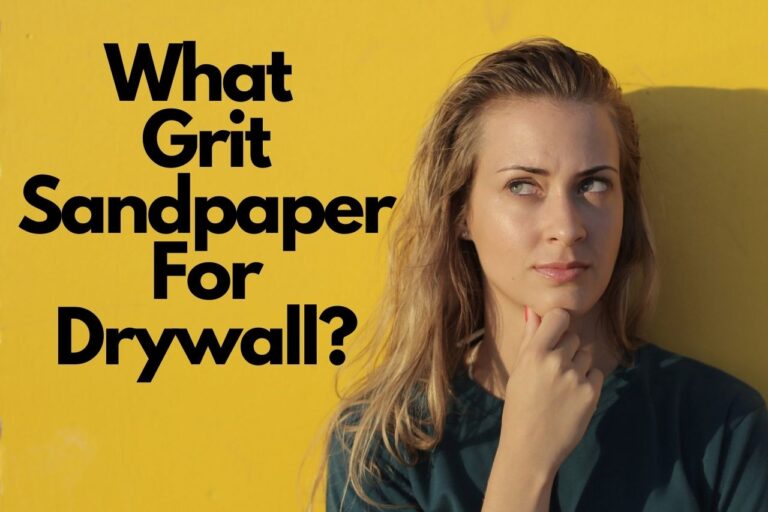
Sanding plasterboard is not a complex technique, but it could be exhausting and messy, and that is not a task for a device. When preparing a newly boarded wall for repainting, you are exfoliating the joint solution for gluing rather than the plasterboard itself. It sands readily, but it requires expertise and attention to make bonded joints vanish beneath a layer of paint. Sanding plasterboard is an essential step in achieving sleek, flawlessly completed walls. Still, you’ll be confused about what grit sandpaper for drywall.
The proper abrasive, grit, equipment, and procedures get required for a paint-ready texture. This guide will reveal plasterboard resurfacing strategies, whether you’re fixing a tiny spot or a large room of new drywall.
Quick Summary: An intermediate gritty sponge or a 100-grit could get used. Use equal sweeps when sanding and prevent pushing too hard. As you rub, go to 150 gritty abrasive and finally to a higher 220 gritty abrasive for a perfect surface, progressing from coarser gritty to higher gritty.
Read more to learn why it’s essential to use the correct plasterboard sanding and how to accomplish your task efficiently.
Using the proper grit abrasive or rubbing clog while completing drywall seams. Your first coatings of plasterboard mud will almost certainly be bumpy and ridged. Using coarse sandpaper reduces wrinkles and straightens out the surface. You’ll require a few extra tools in conjunction with the sanding.
It’s also good to get a double-strap facemask, eyeglasses, and a cap to prevent grit from your head for your protection. To prevent dust from your ears, you could also use earbuds. Whereas these items might appear to be unneeded, they will come in handy when you begin grinding your surface. Let’s look at what grit sandpaper for drywall.
What Grit Sandpaper For Drywall?
Begin with a 120-grit abrasive while scrubbing down the adhesive backing. You might be inclined to use a rougher grit to finish the work faster. Still, anything rougher than 100-grit will produce noticeable scratching in the adhesive backing.
After you’ve sanded away your joints, you may run through all that again with 150-grit plasterboard rubbing paper if you want to. Something thinner than 100 grit would require far too hard to sand. It implies you’re scrubbing by hand using a conventional sander, grip scraper, or plasterboard pole scraper.
If you’re going to use a powered plasterboard abrasive, begin with a 150 grit gypsum smoothing screen. These power equipment smooth walls fast and frequently come with a suction connection or grit collecting device to sweep up particles as you smooth. It is critical to utilize sand screening rather than grit to allow debris to evacuate between the surface and the grinder head.
How To Remove Scuff Marks From Walls? Read HERE.
Best sandpaper
Sandpaper is commonly available in two grades. The grit rating does not need to be puzzled by this. The first category is industrialized employment, while the second category is corporate jobs.
Sanding plasterboard gets best done using open sandpapers such as garnet and aluminum-oxide material. Sandpaper that has not been open-coated will choke after repeated applications.
Aluminum-oxide material burns much slower and lasts for more than Garnet material. Aluminum-oxide material has a stiffer foundation, which extends its lifespan. You can use a similar 100 to 150 grit for your plasterboard job.
Note: If you would like to be particularly cautious about preparing your plasterboard for painting. Even if you’re a novice afraid of damaging your untreated plasterboard, you may cross the border of joints with 150-grit sanding or thinner for a truly clean texture. You may always use ordinary abrasive, commonly known as garnet grit or aluminum-oxide abrasive, generally grey.
If you’re scrubbing a broad-level surface, a rubberized sandpaper block will come in handy. This sanding blocker will assist the abrasive and guarantee that the region you’re washing is flat. When sanding, ensure not to push hard on the filling gap, and excessive force may lead you to go through.
Sanding sponge
The scrubbing sponge is quite helpful also to answer what grit sandpaper for drywall. This ingenious little tool assists you in scrubbing the nooks of the space, getting to those difficult-to-reach regions, performs well for precision sanding, and could even substitute regular abrasive.
Sanding sponges come in rough, moderate, and fine grits, but the moderate gritty is ideal for plasterboard. Abrasive sponges generally fit nicely in your hands, are compact, affordable, long-lasting, and simple to use.
Note: Begin with a 120-grit plasterboard sponge and gradually build up. On every surface of several scrubbing sponges, there are several grits. Dry scrubbing, reaching into nooks, and wet scrubbing are possible with a plasterboard abrasive sponge.
Sanding sponges could get utilized in conjunction with standard abrasives or places. It holds for a sandpaper screen as well. Which is the superior option among a scrubbing sponge and regular sandpaper? Whenever it comes to plasterboard, an abrasive sponge is a preferable option. Because conventional abrasive wears out rapidly, it can be costly to operate.
Drywall Sanding Tips
Sanding plasterboard isn’t difficult; however, there are several precautions you should aim to accomplish a finished look.
- Sand screenings are an excellent substitute for sandpaper. They function similarly, except that they enable sanding grit to travel across and so do not become blocked.
- The goal of sandpaper is to get a smooth finish. Over-sanding will cause the bond solution to break or the plasterboard edges to peek through.
- When drywalling the roof, a pole scraper is a suitable alternative. Pole sanders let you access high spots swiftly and conveniently.
- Use a white sheet to protect the electricity grids and whatever else you don’t want to become filthy.
Bottom line
If you’re sanding drywall for the first time, take your time. Once the joint adhesive has dry thoroughly, use rough grit to smooth off any uneven surfaces. Then, mix the gypsum putty into the drywall using fine-grit abrasive to achieve a smooth surface.